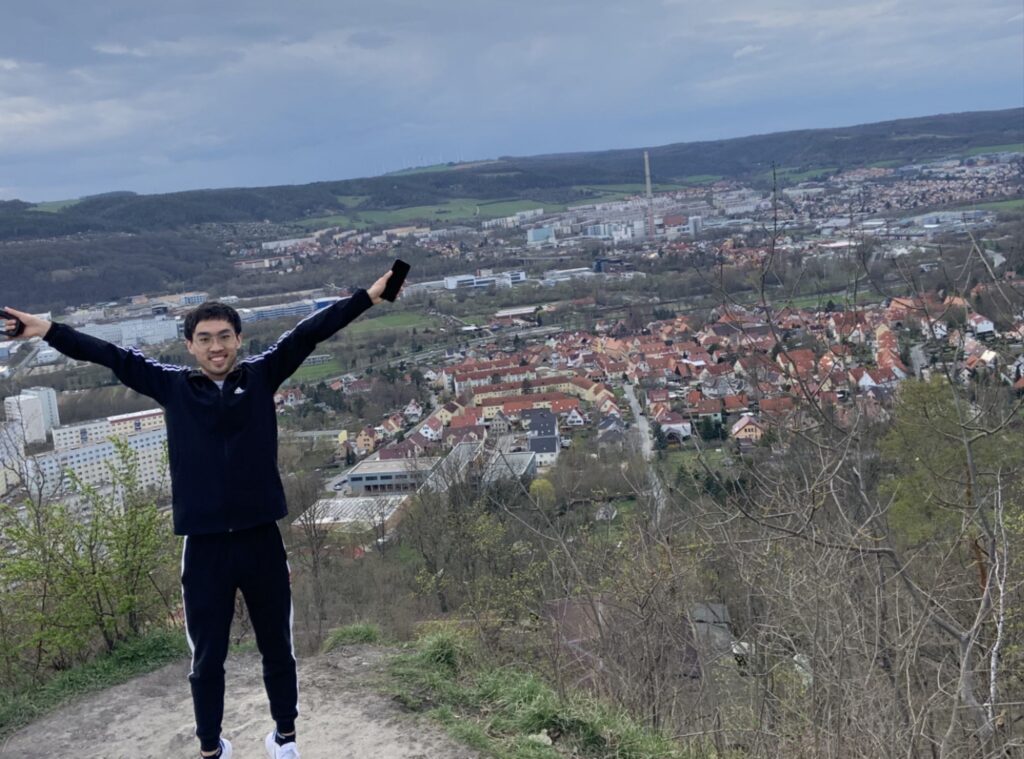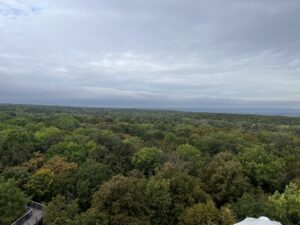This month, we are pleased to spotlight Weijie Zhang, a PhD candidate from the Max Planck Institute for Biogeochemistry in Jena. Weijie’s recent publication, entitled “The effect of relative humidity on eddy covariance latent heat flux measurements and its implication for partitioning into transpiration and evaporation“[link], has been awarded as the “FLUXNET Paper of the Year”. Join us as we delve into the inspiration, challenges, and dedication behind Weijie and his acclaimed research.
– Welcome, Weijie! It is a pleasure to have you join us this month. Could you kick things off by telling us a bit about yourself?
Thanks for having me! I’m really excited to be here. I’m all about Physical Geography and Environment, and I’ve got a master’s degree focusing on tree-ring and climatology reconstruction. Right now, I’m knee-deep in my PhD journey, working with an awesome team of FLUXCOM at the Max Planck Institute for Biogeochemistry and with the H-CEL lab in Ghent University. I’m lucky to have fantastic mentors including Dr. Martin Jung, Dr. Jacob Nelson, Prof. Dr. Markus Reichstein, and Prof. Dr. Diego Miralles, as well as Dr. Rafael Poyatos López from CREAF. I tend to think of myself as a bit of an eco-hydrologist and data science enthusiast, but I’ve also dabbled in ecology, climatology, and playing around with machine learning methods. It’s been quite the adventure so far!
– Congratulations on receiving “The FLUXNET Paper of the Year”, Weijie! Could you share with us what inspired this research, and what challenges did you face while conducting your study?
While I was in the late stage of my master’s, I realized that my key interest is vegetation growth and its role in land-atmosphere coupling. Therefore, I decided to do a PhD and to work with the eddy covariance data (which is the “ground-truth”) and its based upscaling dataset to study the eco-physiology (water-carbon coupling) and eco-hydrology (evapotranspiration). Eddy covariance measurements are really good, but not perfect, mainly due to the well-known energy imbalance problem which would make the turbulent energy fluxes remain large uncertain, and this uncertainty can easily propagate to the global dataset if eddy data is used to train or calibrate model parameters/outputs. So I decided to start my adventure with reducing the long-standing energy imbalance gap from the data-perspective with the theoretical basis and machine learning methods, with support from my mentors. The effort to tackle a long-standing known problem is very hard, but the journey is exciting.
There were several challenges. The first challenge was to thoroughly understand what causes the energy imbalance, which involves sections like eddy covariance assumptions and post-processing. Luckily, I figured it out by reading books and literature about eddy covariance and seeking help from experts in this topic. Another main challenge was to contact all principal investigators across the site network to get the information of the sensor deployed and post-processing implemented, because sensors can be replaced and tower height can be changed in the past twenty years for some sites, even for some sites the principal investigator were changed.
I’d like to share the experience of contacting all the Principal Investigators, which was a headache gathering all the necessary information for each site. In the first round of contacting, I only focused on the sensor type and maintenance history, and it took about one month to get this step done. However, when digging into the problem, we realized that whether and which correction method was implemented to account for the frequency loss during the post-processing step for each site also matters. Therefore, I spent another month to get this detailed information. It’s not about how hard the work was but about how long it. Thankfully, most of them were reachable and happy to contribute to this study. It’s not easy as I initially thought but finally it worked out with the enormous effort and help from the fluxnet community.
– Your paper successfully leverages machine learning, a tool that is becoming increasingly useful in the flux community. Given the wealth of tools now for early-career scientists, such as machine learning, remote sensing, and various programming packages, what guidance would you offer them on navigating these resources effectively?
For python users, I suggest playing with two key packages, scikit-learn (machine learning library) and xarray (handling muti-dimensional dataset). Both packages are well developed, and a bunch of nice tutorials are available. For learning the machine learning methods, to me online courses helped a lot. So online courses in Coursera are good options.
– Could you outline the core areas of your research interests, and more importantly, what drives your curiosity in these areas?
As mentioned, I am really into exploring more about the land-atmosphere coupling and interaction, under this broad topic I specifically interested in the plant water use strategy and how plant can help to mitigate the global warming, as well as what state of the water cycle is and what it will be in the future, considering the potential nature-based-climate solutions.
I’d like to say that my initial interest came from a vanished stream in my hometown. The steam was there for many years but disappeared when I went to high school, I had no clues at the time and I was just sad because I cannot swim there with my friends. Now I think it’s a compound result of global warming and land use change (there was a period of reforestation in my hometown). Twenty years ago, there was a movie called “The Day After Tomorrow”, honestly it shocked a small kid how the world will be after a tipping point of global warming, but also confused me why it can be freezing under global warming. With these curious I have been to different places since high school, and I really saw and felt the warming climate is happening everywhere that I have been. Yes, both we human beings and plants can help. I am still in the adventure and hopefully in the future I can understand how plants can survive and quantify to what extent they can help mitigate global warming and its implications on associated water and carbon cycles.
– Throughout your research journey, there must have been moments that stood out as particularly memorable or transformative. Could you share one or two stories from your experiences that have left a lasting impression on you?
One of the most interesting experiences was a class of eddy covariance. We were taking a practical eddy covariance course at the institute, and one of my colleagues found that a jumping of measured CO2 flux when the teacher (Olaf Kolle) stranded closer to the sensor, and then we tried to have deep breathing to test how sensitive the gas analyzer can be, and finally we got a record, from one meter away, of more than 700 ppm, which almost double of the room CO2 concertation, and the number can be higher if we were facing the sensor. This, I would say, helped us to know the importance of the wind direction and speed on flux measurements in a practical way.
Another amazing experience I want to share with you is about a scientific discussion. One day I had a meeting with Dr Martin Jung and Dr Jacob Nelson to discuss energy imbalances. We discussed a theoretically plausible correction that we wanted to see if it would work in practice, so we stayed in the meeting room from early morning until late afternoon to test our hypothesis. Based on this brainstorming, we came up with a second correction method, and a paper on this has recently been published in Geophysical Research Letters. I am very grateful for this experience, which gave me the opportunity to learn the way that these great scientists think about in solving scientific puzzles.
– Navigating the complexities of scientific research requires not just skill and knowledge, but also a deep well of passion and motivation. Weijie, how do you stay inspired and driven?
I agree. I think it’s helpful to have some long-term and short-term sprint plans. Everyone knows this, but it’s not easy to follow these plans to the letter. My current strategy is to write this down and review it regularly.
Another trick to keep my mind sharp and motivated is to force myself to leave the workplace for a while, such as staying in the library or going to a cafe. I usually read nice review articles, read the difficult parts of the book and try to write down every idea that flashes by. Having said that, I’m really grateful to my advisors who were able to understand me and support me in this regard.
I like coding and I often code in the evenings when I can feel calm and think effectively. During the coding time, when I know what the planned objectives are and what are the potential directions that deserve additional effort. Last but not least, talking to my advisors. Sometimes I could lose my enthusiasm and lose my short-term directions, then I just chat with my advisors and they always gave me useful suggestions.
– As you approach the culmination of your PhD journey, Weijie, do you have any plans for your future career?
There are several directions that I am going to explore. The first one would be the energy imbalance problem, water-carbon coupling, and evapotranspiration partitioning. I just stepped into the adventure of the energy imbalance problem and there are other unknown issues that need to be addressed, for instance, the debate of latent heat or sensible heat fluxes are more underestimated. Besides, with improved “ground-truth” data, I suppose topics like evapotranspiration partitioning can benefit from the data perspective, because data-driven studies are prone to the uncertainties in data and machine learning methods, on top of the necessary assumptions. By reducing the energy imbalance, more accurate quantification of water-carbon coupling and transpiration will be possible. Secondly, I’m also interested in quantifying the potential of nature-based climate solutions and their side effect on the water cycle. I have been keeping my eyes on this topic for two years, and I was involved in a global wood density estimate based on ground measurements. I am still curious about quantifying the potential carbon storage by plants and I hope there will be an opportunity that I can explore some interesting stuff in the next years. The last one is about using state-of-the-art machine learning methods to explore the land-atmosphere interactions and how plants link the two layers, for example, the debate of importance of vapour pressure deficit and soil moisture on plants.
– As we wrap up our conversation, what advice would you share with other early-career scientists who are just beginning their academic journey, particularly within our flux community?
I am not good at giving advice, but I could share some points from my experience. As an early-stage researcher, reading reviews and talking to experts is very helpful in defining my own research interests. I also benefit from attending relevant workshops and conferences. In our institute, all PhD students have regular meetings with all main supervisors to discuss overall progress and define the next adventure, which has really helped me to see where I am in the whole PhD journey.
In addition, for early career scientists in our flux community, it is very helpful to read the eddy covariance handbook and attend the online seminars. There are also regular flux courses throughout the year and previous courses were also recorded, which really helped me to understand the eddy covariance method and the associated uncertainties.


